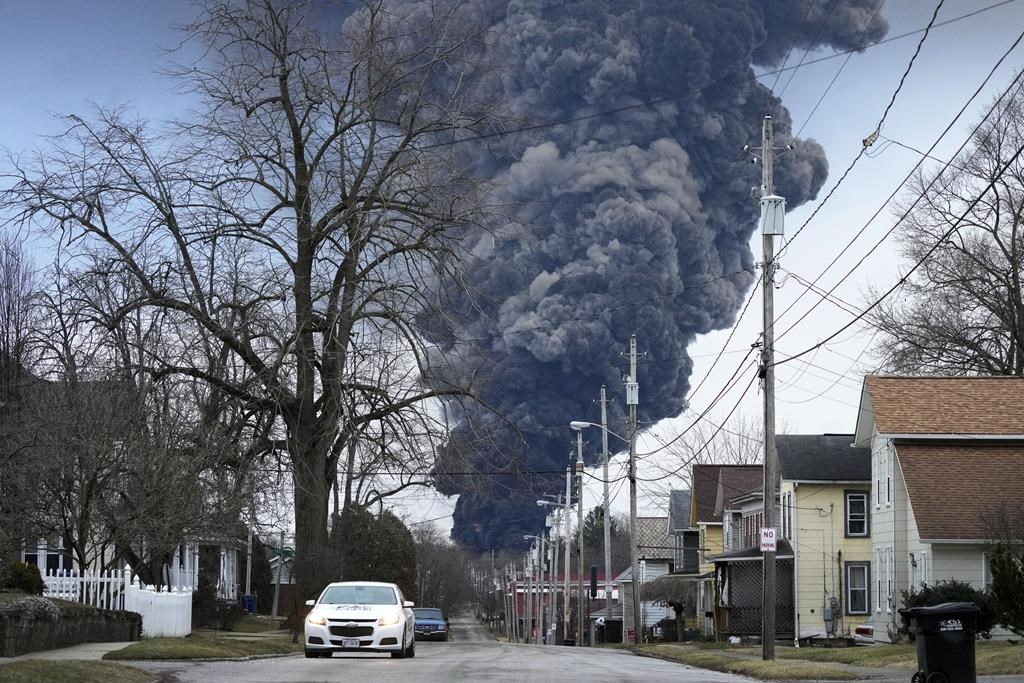Norfolk Southern, the rail company responsible for a disastrous train derailment in Ohio that triggered a chemical leak and set off a massive plume of toxic gas, has agreed to pay US$600 million to settle class-action lawsuits brought by residents of the town of East Palestine.

The settlement has yet to be approved by the court — but if it is, Norfolk Southern says the agreement will settle all class-action claims against the company within a 20-mile radius of the derailment. Individuals and businesses can use the compensation to “address potential adverse impacts” from the derailment, which could include health-care needs, property restoration and compensation for any net business loss.
Residents within a 10-mile radius can file for additional compensation for any past, current or future personal injury stemming from the derailment.
The company said the settlement doesn’t include or constitute any admission of liability, wrongdoing or fault. The settlement is expected to be submitted for court approval within 10 days. Payments to residents could begin by the end of the year.
“This resolution comes shortly after the one-year anniversary of the disaster and will provide substantial compensation to all affected residents, property owners, employees and businesses residing, owning or otherwise having a legal interest in property, working, owning or operating a business for damages resulting from the derailment and release of chemicals,” lawyers representing residents of East Palestine said in a combined statement.
Residents near the site of the derailment filed a wave of lawsuits against Norfolk Southern in the wake of the crash after they reported mysterious health issues and found dead animals in the area.

The crash
The derailment occurred on Feb. 3, 2023, when a train carrying vinyl chloride and nine other hazardous chemicals flew off the rails and started a massive fire just outside East Palestine, a small town of about 5,000.
The wreckage of the crash burned throughout the weekend, but locals said little information was communicated to them until the night of Feb. 5, when forced evacuations began due to concerns the train wreck would explode.
Officials said they observed a “drastic temperature change” in one of the rail cars, and feared a potential explosion could send shrapnel flying up to a mile. To avert the explosion, crews released the contents of five tankers full of vinyl chloride, an extremely combustible and carcinogenic substance that is used in plastic production.
As the toxic chemicals were drained into a trench, crews ignited a controlled burn to get rid of the substances. The burn sent up a massive plume of phosgene gas and hydrogen chloride in a massive black cloud that was visible from meteorologists’ radars. Phosgene gas is highly toxic and was used as a weapon in the First World War.
The aftermath
Two days after the controlled burn and five days after the derailment, officials lifted evacuation orders and told residents they could return to their homes. Authorities, including the Environmental Protection Agency (EPA), said air and water samples had been analyzed and came back normal.
As some residents began to filter back into town, they reported strange smells and dead animals. Hundreds of dead fish were found belly-up in the local tributary, Leslie Run. Some reported dead chickens, dogs and foxes in the area.
An official with the Ohio EPA said material had entered the waterways and killed fish but the drinking water was safe.
Some residents complained about experiencing headaches, nausea and irritation to their throats, eyes, lungs, mouths and lips after the crash. Others said they have noticed rashes on their children and grandchildren.
Concerned residents wondered if it was truly safe to return to the area around the derailment and were skeptical of the EPA’s statements that the presence of dangerous chemicals was “very low.”

For instance, soil samples tested for dioxin, a toxic compound, measured at levels of 700 parts per trillion (ppt), the EPA found. The federal cleanup threshold for residential areas is set at 1,000 ppt.
But in 2010, the EPA itself discovered dioxin was associated with a risk of cancer, so the agency proposed the threshold for cleanup be changed to 72 ppt in residential areas. The proposal to change the dioxin threshold was turned down by the Obama administration at the time.
If these soil samples had been held to that lower standard, the dioxin levels would actually be approximately 10 times above an acceptable level.
The Ohio train derailment was never declared an official disaster in East Palestine, which is a sore point for many residents. Last week federal officials said the aftermath of the train derailment didn’t qualify as a public health emergency because widespread health problems and ongoing chemical exposures hadn’t been documented.
Norfolk Southern has already spent more than $1.1 billion on its response to the derailment, including more than $104 million in direct aid to East Palestine and its residents. The railroad has promised to create a fund to help pay for the long-term health needs of the community, but that hasn’t happened yet.
The head of the National Transportation Safety Board said recently that her agency’s investigation showed that the vent and burn of the vinyl chloride was unnecessary because the company that produced that chemical was sure no dangerous chemical reaction was happening inside the tank cars. But the officials who made the decision have said they were never told that.
The NTSB’s full investigation into the cause of the derailment won’t be complete until June, though that agency has said that an overheating wheel bearing on one of the railcars that wasn’t detected in time by a trackside sensor likely caused the crash.
The EPA has said the cleanup in East Palestine is expected to be complete sometime later this year.
— with files from The Associated Press and Global News’ Sarah Do Couto









Comments